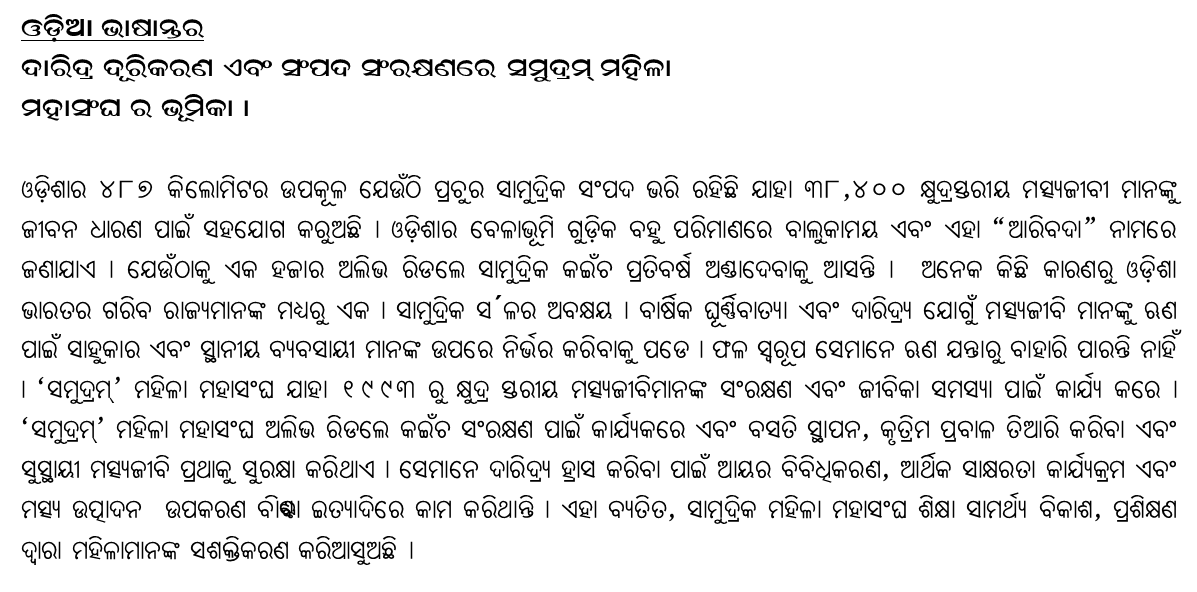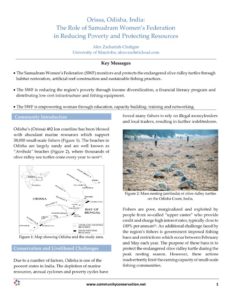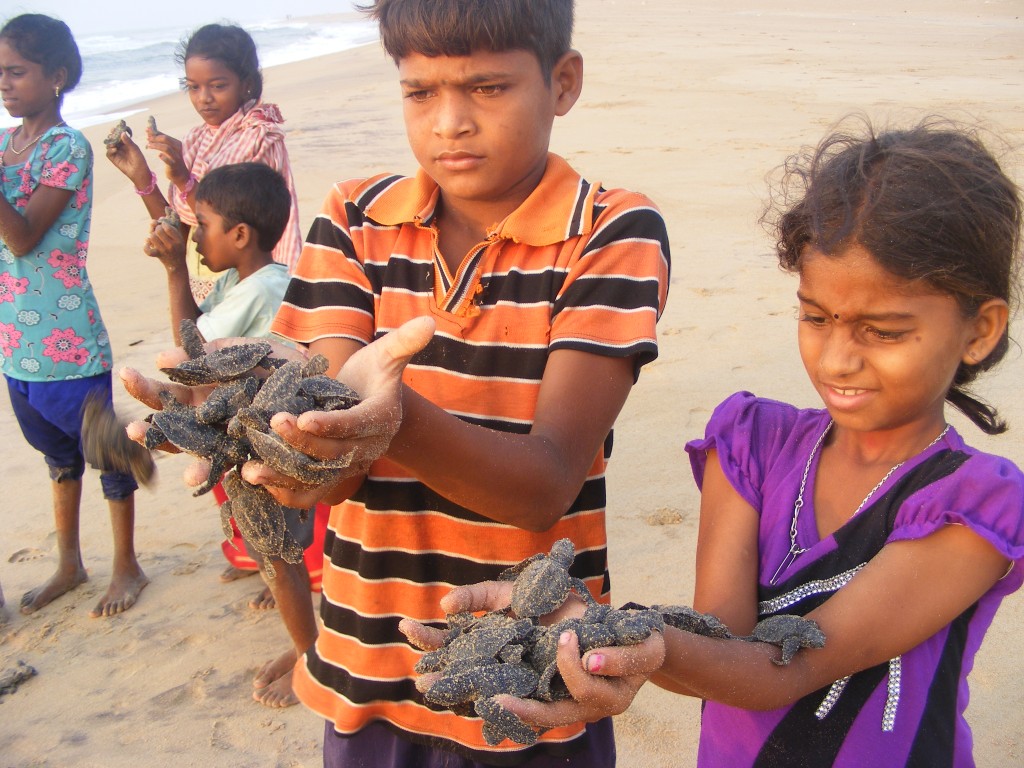
14 Dec Odisha, India
Alex Zachariah-Chaligne,University of Manitoba; alexvzach@icloud.com
Key Messages
• The Samudram Women’s Federation (SWF) monitors and protects the endangered olive ridley turtles through habitat restoration, artificial reef construction and sustainable fishing practices.
• The SWF is reducing the region’s poverty through income diversification, a financial literacy program and distributing low cost infrastructure and fishing equipment.
• The SWF is empowering woman through education, capacity building, training and networking.
Community Introduction
Odisha’s (Orissa) 482 km coastline has been blessed with abundant marine resources which support 38,000 small-scale fishers (Figure 1). The beaches in Odisha are largely sandy and are well known as “Arribada” beaches (Figure 2), where thousands of olive ridley sea turtles come every year to nest(1).
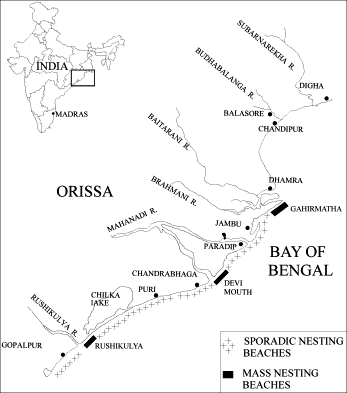
Figure 1: Map showing Odisha and the study area.
Conservation and Livelihood Challenges
Due to a number of factors, Odisha is one of the poorest states in India. The depletion of marine resources, annual cyclones and poverty cycles have forced many fishers to rely on illegal moneylenders and local traders, resulting in further indebtedness.
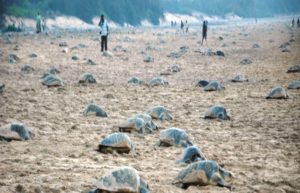
Figure 2: Mass nesting (arribada) of olive ridley turtles on the Odisha Coast, India.
Fishers are poor, marginalized and exploited by people from so-called “upper castes” who provide credit and charge high interest rates, typically close to 100% per annum(2). An additional challenge faced by the region’s fishers is government imposed fishing bans and restrictions which occur between February and May each year. The purpose of these bans is to protect the endangered olive ridley turtle during the peak nesting season. However, these actions inadvertently limit the earning capacity of small-scale fishing communities.
Community Initiative
The Samudram Women’s Federation (SWF) began in 1993 with 250 female members, as a response to conservation and livelihood challenges faced by the small-scale fishers. The SWF now has more than 5,800 members in 160 groups spread over 50 villages along the coast of Odisha. It is both a state level federation of women fish workers and a social enterprise. A key factor to its success, as recognized by the United Nations (2010 Equator prize), has been its joint focus on biodiversity conservation and community enterprise for poverty reduction. “Conservation is multidimensional and holistic, encompassing species, humans, environment and the whole biosphere” – Samudram’s view on Biodiversity Conservation.
The SWF fosters a holistic approach to conservation that is sensitive to local livelihoods and strives to achieve a balance between ecological conservation and social/economic goals. The presence of many complementary factors – economic, environmental, social and cultural – enables the Odisha fishing community to take up conservation and environmental stewardship.
Income Diversification
The SWF forms beach patrol groups with government conservation guards to monitor and protect olive ridley turtles during peak nesting periods. Since these periods coincide with the fishing restriction, beach patrols offer additional income.
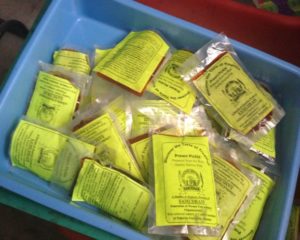
Figure 3: Processed prawn pickle packets ready for the market.
Additionally, the Odisha Forest Department, and other research organizations, provide training in producing value-added marine products (Figure 3), and link the community with wholesale traders and exporters. The SWF provides low cost infrastructure and fishing equipment, and helps distribute relief supplies during cyclones. To address fishers’ dependence on money lenders and the ensuing poverty cycle, the SWF provides a financial literacy programme to encourage households to link up to mainstream banking and credit systems.
Empowering Women
The SWF created a platform for the voice of traditional women fishers to be heard. These women are empowered and made aware of their own rights, gaining improved self-esteem and dignity. Through collaborations, schools and adult education centres have been created. These resources have allowed members to improve their quality of life through education, increased literacy and better health practices. Exposure to mainstream media and institutions has boosted the confidence and pride of many traditionally disadvantaged women, allowing them to counter and question any law or system detrimental to their interests. “Being a Samudram member means being a vehicle of change in my community” – Samudram Member.
Community Conservation
Small-scale fishers have deep-seated beliefs about how to treat other living beings and their food basket, the sea. They see everything as a gift from Mother Ocean and ocean creatures such as turtles are seen as their brothers and sisters. Fishers take pride when thousands of turtles choose to return annually to their beaches to breed and nest and they take special care of these visitors (Figure 4). Beach patrols offer the community an opportunity to give something back to their Mother Ocean. “The health of the ocean is dependent on these turtles, if there are more turtles, the sea is healthy and there will be more fish” – Samudram Member.
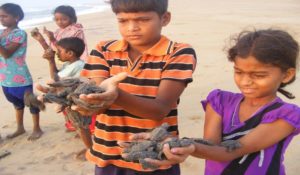
Figure 4: Children holding the turtle hatchlings before releasing them into the sea.
The majority of households living on the coast self-identify as followers of the Hindu religion, where turtles are considered as one of the avatars of Lord Vishnu. Since Lord Vishnu is the preserver of life, some members of this community consider protecting turtles to be their responsibility. “Out of all the beaches, these turtles chose mine to lay their eggs. It means they trust us with their future and we are proud that they chose us and we make sure that we keep this trust” – Samudram Member.
Practical Outcomes
The Samudram Woman’s Federation is reducing poverty and protecting biodiversity through a number of different initiatives:
• Promoting the conservation of marine resources, and sustainable fishing practices to protect marine biodiversity.
• Linking economically marginalized fishing communities to wholesale markets and exporters.
• Generating income during fishing restriction periods through beach patrols and by selling value added and processed marine products (e.g. dry fish, pickles, papads).
• Gender empowerment through capacity building, training, knowledge dissemination and
networking.
• Community social development through building schools, health centres and organizing medical camps.
• Developing a community cooperative enterprise by providing social, financial and infrastructural support to local fishers.
References
1. Karnad, D., Isvaran, K., Kar, S.C. & Shankar, K. (2009). Lighting the way: Towards reducing misorientation of Olive ridley hatchlings due to artificial lighting in Rushikulya, India. Biological Conservation, 142(10): 2083-2088.
2. Nayak, P.K. & Berkes, F. (2010). Whose marginalization? Politics around environmental justice in India’s Chilika lagoon. Local Environment, 15(6): 553-567.
Acknowledgements
The author wishes to thank the following: The team of Samudram Women’s Federation and United Artist’s Association, Ganjam; Parvathy for her help in conducting and organizing interviews and group discussion, and being a great help as my interpreter; Mangaraj Panda and Govind Panda for their everyday help; The team at CBRM, Natural Resources Institute, University of Manitoba; Dr. Fikret Berkes for his timely advice and suggestions at every instance of the research; Durdana, Eranga, Ian, Dilbar and Alex for their help and support; and finally to all the fishing community in Nolianuagaon, Purnabandam, Arjyapally and Gokurkudham for allowing me to be a part of your community.
See below for the Odia language abstract for this community story.
